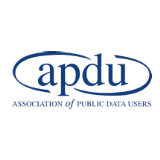The Census Bureau’s solution to protecting privacy is a new DAS based on a methodology referred to as Differential Privacy (DP). The Census commissioned the Committee on National Statistics (CNSTAT) of the National Academies of Sciences, Engineering and Medicine to host a 2-day Workshop on 2020 Census Data Products: Data Needs and Privacy Considerations, held in Washington, DC, on December 11-12, 2019. This post provides an overview of the findings.
Continue Reading
APDU is welcoming proposals on any topic related to the privacy, accuracy, and access of public data. Proposals can be for a single presentation or panel, whether based on a particular project, data practice, or formal paper. In keeping with the theme of the conference, our interest is in highlighting the breadth of public data to both producers and consumers of public data. Deadline: February 28, 2020.
Continue Reading
The next nationwide count starts in most of the country this March, and companies can help ensure its accuracy by encouraging employees and customers to participate.
Continue Reading
The House has passed appropriations bills to the Senate for FY2020, and there are important developments for statistical agencies. The Census Bureau, Bureau of Labor Statistics (BLS), and Bureau of Economic Analysis (BEA) each received modest to substantial increases in their budgets.
Continue Reading
Congratulations to this year’s winners! Register for the 2019 APDU Annual Conference today to learn from awardees about how they created these excellent visualizations.
Continue Reading
Although many APDU Conference attendees show up to share information about their government agencies’ data products, private companies like PolicyMap have a compelling business reason to attend: it’s the easiest, most reliable way to learn about what’s in store for data, and data is our lifeblood.
Continue Reading
The 2019 Association of Public Data Users (APDU) Annual Conference, “Wide World of Data,” will be the place to be July 9-10! The meeting will not only offer attendees cutting edge information about advances affecting public data collection, dissemination, and application, but also will provide them with insights into the politics and policies affecting federal statistical agencies and surveys.
Continue Reading
If you ask a data user to name public data sources, she might name the decennial census, American Community Survey, National Vital Statistics System, or Current Population Survey. Each of those sources provides robust, timely, accurate public data on important topics like population, housing, and employment. Yet the “big name” public data sources merely hint at the breadth and depth of data available, which includes information on consumer expenditures, healthcare access and utilization, and participation in the arts.
Continue Reading
Be sure to register for the 2019 APDU Annual Conference! The conference is being held at the Key Bridge Marriott in Arlington, VA on July 9-10. The agenda is set and there are some very exciting speakers.
Continue Reading
As 2019 APDU Annual Conference Committee Chair, I would like to cordially invite you to attend what is shaping up to be a fantastic 2019 APDU Annual Conference July 9 – 10 at the Key Bridge Marriott in Arlington, VA.
Continue Reading







